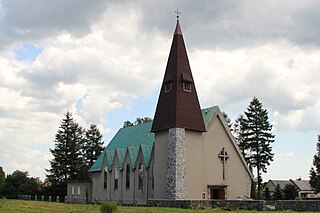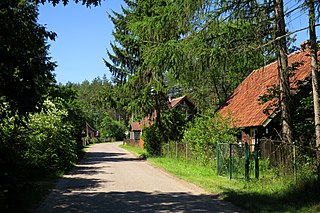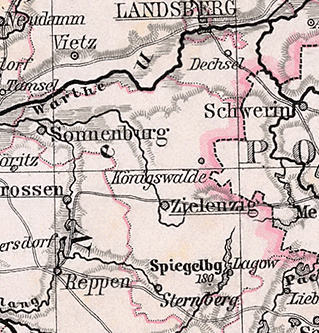
Gartz is a town in the Uckermark district in Brandenburg, Germany. It is located on the West bank of the Oder River, on the border with Poland, about 20 km south of Szczecin, Poland. It is located within the historic region of Western Pomerania.

The Province of Upper Silesia was a province of the Free State of Prussia from 1919 to 1945. It comprised much of the region of Upper Silesia and was eventually divided into two government regions called Kattowitz (1939–1945), and Oppeln (1819–1945). The provincial capital was Oppeln (1919–1938) and Kattowitz (1941–1945), while other major towns included Beuthen, Gleiwitz, Hindenburg O.S., Neiße, Ratibor and Auschwitz, added in 1941. Between 1938 and 1941 it was reunited with Lower Silesia as the Province of Silesia.

Jerichow is a town on the east side of the river Elbe, in the District of Jerichower Land, of the state of Saxony-Anhalt in Germany. With about 270 square kilometres (100 sq mi), the municipality of Jerichow is one of the largest municipalities in area size in Germany.

The Province of Pomerania was a province of Prussia from 1815 to 1945. Pomerania was established as a province of the Kingdom of Prussia in 1815, an expansion of the older Brandenburg-Prussia province of Pomerania, and then became part of the German Empire in 1871. From 1918, Pomerania was a province of the Free State of Prussia until it was dissolved following World War II by decree of the Allied Control Council with the de jure abolition of Prussia on 25 February 1947, and its territory divided between Poland and Allied-occupied Germany. The city of Stettin was the provincial capital.

Wandlitz is a municipality in the district of Barnim, in Brandenburg, Germany. It is situated 25 km north of Berlin, and 15 km east of Oranienburg. The municipality was established in 2004 by merger of the nine villages Basdorf, Klosterfelde, Lanke, Prenden, Schönerlinde, Schönwalde, Stolzenhagen, Wandlitz and Zerpenschleuse.

The Landkreis Stolp was a Brandenburg-Prussian district in Farther Pomerania formed in 1648 from the Landvogtei Stolp. It weathered the alterations of the Farther Pomeranian district borders in 1724 unchanged. In 1815, with the introduction of government regions, Stolp District became part of the new Köslin Region in the enlarged Province of Pomerania in Prussia, part of the German Federation (1815-1866), North German Confederation (1867-1871) and the united Germany of 1871.

The Landkreis Sprottau was a district of the German state Prussia from 1816 to 1945. It was part of the Prussian Province of Lower Silesia, before 1919 the Prussian Province of Silesia. In 1932 it was merged with Landkreis Sagan. Its present-day successors are Powiat Żagański and Powiat Polkowicki. On 1 January 1945 it included:

History of Pomerania (1806–1933) covers the history of Pomerania from the early 19th century until the rise of Nazi Germany.

Łąka Prudnicka is a village in the administrative district of Gmina Prudnik, within Prudnik County, Opole Voivodeship, in south-western Poland, close to the Czech border. It lies approximately 4 kilometres (2 mi) west of Prudnik and 49 km (30 mi) south-west of the regional capital Opole. Historically located in Upper Silesia, in the Prudnik Land.
Borowina is a village in the administrative district of Gmina Przywidz, within Gdańsk County, Pomeranian Voivodeship, in northern Poland. It lies approximately 5 kilometres (3 mi) south of Przywidz, 25 km (16 mi) south-west of Pruszcz Gdański, and 32 km (20 mi) south-west of the regional capital Gdańsk.

Gardna Wielka is a village in the administrative district of Gmina Smołdzino, within Słupsk County, Pomeranian Voivodeship, in northern Poland. It lies approximately 5 kilometres (3 mi) south-west of Smołdzino, 21 km (13 mi) north-east of Słupsk, and 100 km (62 mi) west of the regional capital Gdańsk.
Gorczyce is a village in the administrative district of Gmina Prostki, within Ełk County, Warmian-Masurian Voivodeship, in northern Poland. It lies approximately 6 kilometres (4 mi) south-west of Prostki, 18 km (11 mi) south of Ełk, and 124 km (77 mi) east of the regional capital Olsztyn. It is a sołectwo of Prostki.

Końcewo is a village in the administrative district of Gmina Ruciane-Nida, within Pisz County, Warmian-Masurian Voivodeship, in northern Poland. It is a sołectwo of Ruciane-Nida.

The Region of Stralsund belonged to the Prussian Province of Pomerania and existed from 1818 to 1932.

The district of Oststernberg existed in the Prussian Province of Brandenburg in Germany from 1873 to 1945. Today, the former territory of the district is part of the Sulęcin County of the Lubusz Voivodeship in Poland. The district included the four towns of Königswalde, Sonnenburg, Sternberg (Neumark) and Zielenzig.

The coat of arms of the town of Białogard, Poland, depicts a red griffin standing on its back legs, above the blue horizontal wavy line. The current coat of arms was established in 2004.
The Belgard District is a former district in Eastern Pomerania that existed from 1818 to 1945. The Belgard District belonged, successively, to Prussia, the German Empire, the Weimar Republic and the Third Reich. The district seat was the town of Belgard on the bank of Persante. The area under this former district is now split between two powiats: Białogard and Świdwin Counties, both of which are under the Polish West Pomeranian Voivodeship.

The von der Osten family [ ˈoːstən ] is an ancient and distinguished aristocratic family from Pomerania that has been established in Pomerania since 1248, originally from Stift Bremen. The family's ancestral home is in Lower Saxony, near the Oste River. The family acquired numerous properties in Western and Eastern Pomerania, becoming one of the largest landowners in Pomerania. In 1854, the von der Ostens were one of the first ten families to hold the hereditary right of presentation to the Prussian House of Lords.
Heilsberg was a district in East Prussia and existed as a Prussian-German district in the period from 1818 to 1945. Due to its affiliation with Warmia, the district had a majority Catholic population, and the Center Party won an absolute majority of votes in elections until 1933. From 1773 to 1818, there had already been a district of Heilsberg in Warmia, which covered a much larger area.















